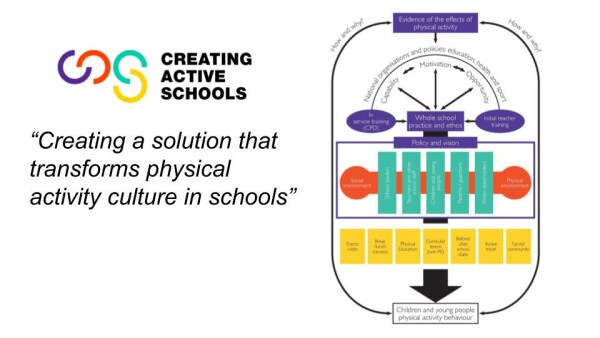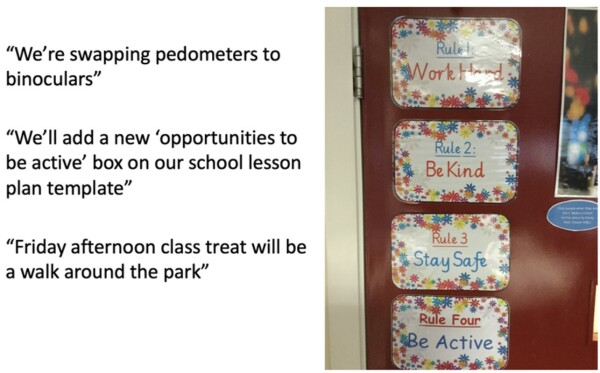Getting kids active - what schools can learn from the NHS about behaviour change

You’ve probably heard of the Daily Mile which sees pupils run a mile a day in school grounds. It’s one of many interventions used to get kids moving and yet despite this and other opportunities, our children are leaving primary school more obese and less active each year.
Recently a group of academics, experts and school leaders decided to get together to work out what’s happening and why we’re not achieving the long-lasting behaviour change we desperately need.
They came up with the research-based Creating Active Schools Framework which puts physical activity at the heart of every aspect of school life, based on the same principles the NHS and public health use to effect behaviour change on issues such as smoking.
And here’s where school governing boards come in. The framework sits at a strategic level and becomes part of a school’s overarching vision for its pupils.
We caught up with Dan Wilson, who’s Director of Development at the Yorkshire Sport Foundation and the Chair of Governors at Aspin Park Academy in North Yorkshire, to find out how governors and trustees can work with school leaders to create system change and get every child regularly active.
Dan, how did the framework come about?
A few years ago some colleagues from Leeds Beckett University, Public Health England and Yorkshire Sport set out to understand why schools struggle to get every child regularly active and to find some solutions. We wanted to investigate how school leaders can create permanent and positive change to address declining activity levels and understand the wider benefits of being more active. For some children and staff, ‘sport’ can be a daunting concept and many teachers worry about teaching PE but this is about simply moving more.
Fifty experienced stakeholders were involved in creating the framework, from across research, education, health and sport sectors. . They came together over two days at Leeds Beckett University and said, ‘let’s try to crack this nut’. Through open and honest reflection and joined up collaboration, we developed a unique whole-system behaviour change approach to physical activity in schools.
What does the framework involve?
It’s important to understand that this is not an intervention or one-off measure. These can sometimes act as a short-term band aid - superficially covering over the holes. It’s a whole-system approach which looks at physical activity in relation to every aspect of school life that can affect outcomes for pupils.

The arrows around the top of the model, ‘capability’, ‘motivation’ and ‘opportunity', are derived from Michie et al's COM-B model of behaviour change (2011) that's used by public health and the NHS when designing interventions on issues such as smoking cessation or obesity. When you want to change behaviour, you need to address capabilities and motivation not just provide more opportunities and it’s exactly the same for schools.
There is no shortage of opportunities to get children active but what we rarely address is the ‘motivation’ and ‘capability’ in order to effectively change behaviours - This is why many interventions end up lasting only a couple of months.
Thinking more strategically and bringing physical activity into a school’s vision, culture and policies will help with this. Physical activity can’t just sit with a PE leader- it needs real senior level prioritisation in order to ripple throughout the whole school.
This is something that has never been addressed before - positioning physical activity at the heart of school strategy, culture, policy, vision, ethos and practice. It’s starting where the school is at, understanding what its priorities are and then really thinking strategically about how physical activity can support better outcomes in those priorities.
Active learning is a big piece of our work; simply increasing the amount of time children are up and moving around the classroom. There is a lot of research that shows physical activity improves memory retention and understanding.
Schools have told us that a barrier to this can be the perception from leaders about what ‘good learning behaviours’ are and effective pedagogy is. For example, if there’s a learning walk with governors or an inspection team and they see children moving and talking around the classroom, that can be perceived as bad practice because children don’t appear to be concentrating or working. That’s where the social environment part of the framework comes in (see left-hand side of the framework). Teachers must feel empowered to be able to increase physical activity in their classroom. This is a culture change that has to be driven from the top and can be a big obstacle to get over.
The boxes along the bottom are all the tangible opportunities children have across the school day to embed physical activity, all informed by research. Starting from the centre, as you work your way to the left, are areas where the school has control and to the right are areas where the school has an influence. We encourage schools to look at all of these areas.
The problem with school visions…
The trouble is, very often school visions are not fit for purpose. When we take the framework to school leaders we start by asking what their vision is. We’re frequently met with blank faces and occasionally they even have to look it up on their phones! I personally believe we should be measuring success against this too. If your school’s vision includes language such as ‘happy, healthy children that reach their full potential’, why are we only measuring achievement in English, Maths and science? Visions and outcomes are often unaligned. As governors, it’s within our gift to really hold the school to account on the vision.
Either change the school vision to say ‘we will create pupils who are good at English and maths’ or have a legitimate vision which serves a purpose and provides staff, pupils and the community with an inspiring ambition. And then devise ways to measure that to see how well you’re doing against it. Not many businesses would survive long if they’re not aspiring to achieve their vision or measuring progress against it!
I’ve been working with Elevate Multi Academy Trust in North Yorkshire to create training for school leaders about how to create, embed and measure school visions so that they really do contribute to school improvement.
How many schools are working with the framework? Have you got any success stories?
We’ve started to take the framework to schools and always start by listening to the priorities emerging from their improvement plans. Often they tell us ‘We’re an active school because we do plenty of after school clubs and enter competitions’. To that we request that they look at the bigger picture and consider the school’s vision and improvement plan. Then they start to see where the gaps are and we share ideas to improve.
We’ve written an informal impact study about some of the learnings to date involving 40 schools in Bradford. We’re also expecting our first piece of academic research soon and the early anecdotal evidence is strong so far.

A really good example of how a small but significant strategic change can improve activity levels is illustrated by a school which had three school rules when we started working with them. After reviewing the framework they introduced a fourth rule: to ‘be active’. That is a really simple, zero cost, behaviour change that’s embedded across the whole school. Teachers are encouraging pupils to work hard, be kind, stay safe and now, be active!
Across the Active Partnership network, there are 18 counties using the framework which equates to around 400 schools in England (and Guernsey). That might be five or six targeted schools in small geographic areas or those that really need support with physical activity. Alternatively, some partnerships are working on a larger scale with every school in their area. We’re learning so much about ways that the framework is being implemented - what works well and how we can scale it up and make it more successful.
Many schools have asked for something more tangible to help measure the impact of their work on the framework so we’ve developed an online system that will audit, track and support schools to embed some of these behaviours. Our system asks 100 questions around what the school is doing in all the different tiers of the framework and then produces an action plan which identifies some areas for improvement that link directly to CPD modules we’ve developed to help schools change effectively. We’re piloting this at the moment and hope that it will be available in September 2022.
Governors and trustees are probably wondering how this fits into the PE and Sport premium?
I’ve been involved in consultations with the Department for Education for the last few years, looking at how schools spend the PE and Sport Premium. Many schools spend the money on sports equipment or hiring coaches to run extra curricular clubs and often this is not sustainable or changing behaviour for the long term. We need to educate schools to understand what the money should be spent on to have the biggest, most sustainable impact. One of the key performance indicators for the grant, is using physical activity to help whole school improvement and the framework can really help with this.Start by conducting an audit to discover where the gaps are and then plan with colleagues and pupils across the school to fully incorporate physical activity. The PE and Sport Premium should be viewed in a far more strategic way.
If a governor or trustee wants to start bringing some of these ideas to their next meeting what’s the best way to do this?
- Familiarise yourself with the framework (CAS framework video) and get in touch with your local Active Partnership who may be able to help you understand how to best embed it in your school. Their services are free and funded through Lottery and Sport England
- Familiarise yourself with the PE premium and its key performance indicators and then align your school’s spending to it. Ask what the school is doing at a strategic level around physical activity.
- Ask how physical activity helps wider outcomes in the school such as wellbeing, attainment or behaviour. Then use the CAS Framework to identify strengths and gaps in your provision of physical activity. You don’t need any training to be able to use the framework. For governors and trustees, it’s about stimulating a strategic conversation with school leaders.
Questions governors should be asking:
- How does physical activity contribute to priorities in our school development plan?
- Is the school’s vision inspiring, driving improvement and understood by all stakeholders?
- Are all five of the PE and Sport Premium KPIs being achieved?
- Is the grant being spent in a strategic and sustainable way?
- Does the social environment of the school support an ambition to reduce sedentary behaviours?
What would you say to the person who receives kickback? A leader who says, ‘well that’s all very well but we’re still struggling after the pandemic and we just need to get back on our feet first - this is icing-on-the-cake stuff.’
This is a perfect example of how physical activity is often misunderstood and undervalued. The role it can play in improving outcomes across the school needs clarifying. Referring back to COM-B, consider the motivations that sit behind this belief and change the conversation to what the schools priorities are since the pandemic. We know that wellbeing, social skills and behaviour have been negatively impacted and that using play, movement and activity can all contribute to helping address these.

Post your comment
Comments
No one has commented on this page yet.
RSS feed for comments on this page | RSS feed for all comments